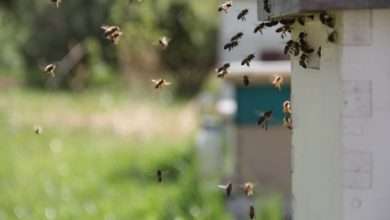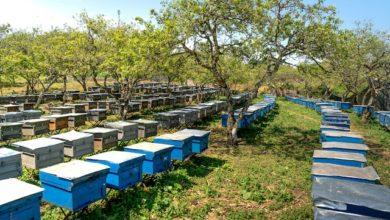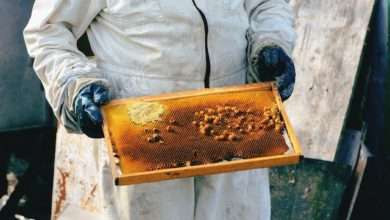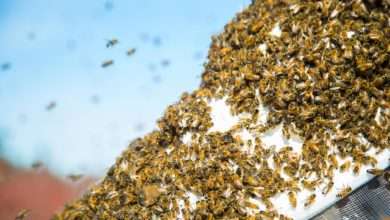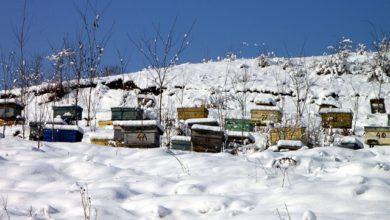Queen Honey Bee
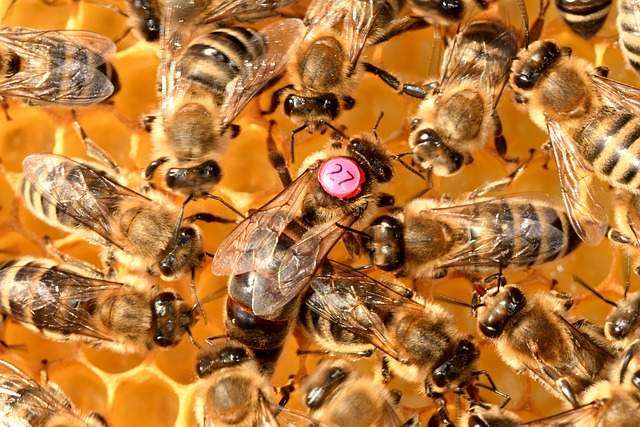
The largest of bees in a honey bee (Apis mellifera) colony is known as the honey queen bee.
The honey queen bee measures around 2 centimeters, which is approximately two times the length of a worker. Workers are slightly smaller than drones.
Spotting honey bee queens among thousands and thousands of worker bees are difficult for the human eye despite them being larger than workers.
Because of this, honey queen bees are usually marked with a dot of special paint on the thorax. The color changes every year, which indicates the age of the queen. Here is the best queen marking kit.
The honey bee queen may lay about 1000 eggs each day at a rate of one egg every 20 seconds as she establishes her colony.
The colony may decide to replace the honey queen bee with a new queen if she is not performing very well (if she is not laying enough eggs, for example). This process is known as supersedure.
There will be only 1 queen and around 300 drones (males) in a colony of 50,000 bees. The remaining bees in the colony will be female worker bees.
There may be two queens at exceptional times but this is not for very long.
• The role of the queen honey bee in a colony is to start new colonies through swarming, mate with drones (males), and produce new eggs.
How Do Honey Bees Become Queens?
What may surprise many is that the honey queen bee is produced from eggs that are in every way identical to those egg-producing workers despite the difference between herself and the female workers.

However, the larvae of potential queens are fed only a special substance called royal jelly is the only difference.
Mating Behaviors
A new queen will require numerous fights before she can mate, which takes place about a week after she emerges from her confinement.
Up to 40 drones may mate with her simultaneously while she is in the air. Unfortunately, the drones perish after mating.
On the other hand, the new queen will only rarely leave the colony when she returns to lay her eggs. She will have enough sperm inside of her, which she stores in her spermatheca, to allow her to continue fertilizing her eggs for the remainder of her life.
The workers begin fussing over the new honey bee queen when she returns to the colony from her nuptial flight. The honey bee queen will return to the colony after being impregnated.
They feed her, causing her belly to grow, and lick her, which transfers a chemical (pheromone) that is used to control the colony.
The Queen Pheromone and Communication
The drones, workers, and even the honey queen bee produce pheromones. However, the queens produce the ‘queen pheromone’.
The purpose of the queen pheromone that is produced by the honey queen bee is to prevent the production of more queens whilst at the same time encouraging workers to tend to her and the brood.
The pheromone is so efficient in the communication within the colony to an extent that if the queen is removed from a hive, it will take a few minutes for all the bees to know it and frantically start the task of creating a replacement.
A new colony will be formed when the colony becomes very large so that the workers cannot detect the queen pheromone.
The colony can become very large when the distance between the workers and the queen grows large and the detection of the queen’s pheromone becomes less. This will lead to the formation of a new colony.
“Bee swarming” is then started. While “scout bees” hunt for a good spot for a permanent nest, a group of workers encircling a queen honey bee may be seen taking a brief break on a tree branch or post.
The “old queen” will, however, depart rather than the “new queen” in order to locate a suitable new nest.
The lifespan of the honey queen bee is much longer than that of workers and drones. The queen might live two or three years, but she might even live four or five if she does well in the colony.
She might be replaced by a new queen if she lays an insufficient number of eggs. The replaced old queen will be left to waste away while the new queen is pampered with food and affection.
Facts About the Queen Bee
Here are the facts about the queen bee:
• The Honey queen bee is the most important bee in the entire colony and she is also the only one in her caste. The main job of the honey bee queen is to lay all the eggs in the hive and she is to lay a lot of eggs.
• Despite what her name might imply, she is not actually the colony’s ruler. This is a result of the colony’s more democratic structure. The worker bees, for instance, participate in voting for the swarm’s subsequent nesting place.
• Up to 2,000 eggs are laid by the queen bee every day. After every 43 seconds, a honey bee lays one egg.
• All the eggs in the colony are laid by the queen bee since that’s her responsibility.
• The size of the egg laid by the queen bee is about the half size of grain rice (Around 1 – 1.5 mm long).
• The queen bee can be produced from any fertilized egg.
• The eggs laid by the honey queen bee can either be fertilized or unfertilized. When the eggs are fertilized, they become workers or can even become a queen while the unfertilized eggs turn into drones.
• The diet of the larvae is what determines whether the egg will become a queen since the queen bee larvae are exclusively fed royal jelly while worker larvae consume a diet of honey and pollen.

• The queen only mates once in her life.
• When the queen bee is new, she will mate with as many drones as possible within a day or two. After that, the sperm is collected and then stores the sperm in a special organ which she will then use to lay eggs for the rest of her life.
• The queen will be replaced by the colony once she runs out of genetic material.
• New queens must kill their competitors. Worker bees will make more than one queen when the colony needs a new one.
The reason for more than one queen is to provide them with a better chance of having a strong queen. Despite several queens being produced by workers, only one can stay in the hive. She uses her stinger to kill the unhatched queens when a new queen hatches.
If two queens emerge at the same time, they will engage in a deathmatch, with the victor taking control.
• In the colony, the honey bee queen is the largest. Compared to the tips of her wings, her abdomen is much more protruding. She also has long, light-colored legs and a sleek, hairless black back.
This is compared to worker bees, who have shorter, black legs and hairy backs. To make them easier to find, some beekeepers paint a small dot of color on their queens.
• Without a queen, a colony cannot survive. The entire colony’s survival rests on the honey queen bee.
The two primary functions of the queen are to lay eggs and to create pheromones, which are chemical odors used to communicate with other members of the colony.
Workers use their antennae to spread pheromones in the entire hive. The workers know they are without a queen once they notice there are no pheromones in the hive.
Once the workers realize they are queenless, they will start creating a new queen by constructing queen cells.
• The queen bee has a reusable stinger. The queen bee can sting several times, unlike the workers that can only sting once and then die.
Worker bees can only sting once because they have barbed stingers that when they try pulling out after causes them to have massive abdominal rapture hence leading to their death.
On the other hand, honey queen bees have a smooth stinger that is easy to pull. The queen’s stinger has another crucial use since it has a modified ovipositor which it uses to lay and position its eggs.
• The Queen has attendants. If the queen’s attendants did not take care of her all the time, she would die. She is fed, groomed, and her waste is removed by these bees. For her, they even have to digest food. The food is digested before being given to the queen because she lacks the glands that worker bees need to do so.
FAQs
1. What is special about queen bee?
The queen bee is the only female with fully developed ovaries which she uses to play a vital role. The Queen bee is special since she is the only female with fully developed ovaries.
The main functions of the queen are to lay a lot of eggs and create chemical scents that help maintain the colony’s unity.
2. Do queen bees have power?
If she is performing effectively, she can lay up to 1,500 eggs in a day, putting one egg in each cell.
Contrary to popular opinion, the queen bee is not in charge of the colony even though she is essential to everything that takes place inside the hive. In actuality, the queen is managed by thousands of worker bees.
3. What happens when the queen bee dies?

A colony of bees without a queen cannot, regrettably, last for very long. Worker bees may behave aggressively and agitatedly when there isn’t a queen bee around.
Despite the fact that worker bees may still lay eggs because they are not fertilized, they always develop into drones instead of workers.
4. How long does a queen bee live?
Honey bee workers typically survive 15 to 38 days in the summer and 150 to 200 days in the winter, compared to the average lifespan of 1 to 2 years for queen honey bees.
5. How many times can a queen bee sting?
A queen bee’s stinger is smooth, so theoretically, she can sting numerous times without losing it and passing away in the process.
This is not the case with worker bees, who lose their stingers and pass away while stinging.
6. Is a queen bee sting worse?
The queen bee does not typically exit the hive, but she does have a barbed but smoother stinger and can, if necessary, hit skin-bearing creatures many times.
She never uses her sting to defend herself; instead, she only employs it to eliminate other queens, ideally before they can leave their cells.
7. Are queen bees born or made?
Worker bees choose larvae that are particularly nourished in order to develop into sexually mature queen bees.
In a hive, there is often just one mature, mated queen, and when that happens, the bees will usually follow and aggressively guard her.
8. Why do bees reject a queen?
Even when they have little chance of producing a new queen of their own, older worker bees will reject unfamiliar queens and prefer to consider them as colony invaders.
This is particularly relevant if the queen is improperly or infrequently mated with drones from various unrelated colonies.
9. Can queen bees fly?
A honey queen bee can fly, indeed. Like the workers and drones, she has robust wings. And based on the facts about the honey queen bee mentioned above, she requires them if she leaves the hive.
10. How is the queen bee chosen?
A strict diet of royal jelly, a milky white material that bees make from the crowns of their heads, will be fed to 10 to 20 freshly hatched female larvae by nurse bees.
The female larva’s reproductive system activates when fed just royal jelly, transforming her into a queen.
11. Why are queen bees bigger?
More eggs are first laid by the queen. Then, it appears that at random, the worker bees select twenty of the fertilized eggs to serve as future queens.
When these eggs hatch, the workers give the larvae a unique diet called royal jelly. In comparison to the worker and drone bee larvae, this aids in larvae growth.
12. What happens if two queens meet?
However, because a hive can only have one queen (usually), when the new queen hatches, they must slay their rivals.
An unhatched opponent will be killed while they are still in their cages by a newly born queen’s sting.
Two queens must fight to the death if they hatch at the same time.
13. Do queen bees leave the hive?
The only female in a honey bee hive that can lay fertilized eggs is the queen. She takes a mating flight to do this.

The queen will leave the hive soon after hatching and defeating her rival to fly to a drone aggregation place, where thousands of drones have assembled to mate with the queen.
14. Does a queen bee need a male?
Since most animals reproduce sexually, both men and females are necessary for the survival of the species.
The female queen of the honey bee normally creates new offspring by laying eggs that have been fertilized by sperm from male drones, and the honey bee is no exception to this rule.
Summary
The queen bee is incredibly fascinating, as these facts about her have demonstrated. The queen is the most significant bee in the colony, playing a crucial role in everything from her birth to colony expansion.
